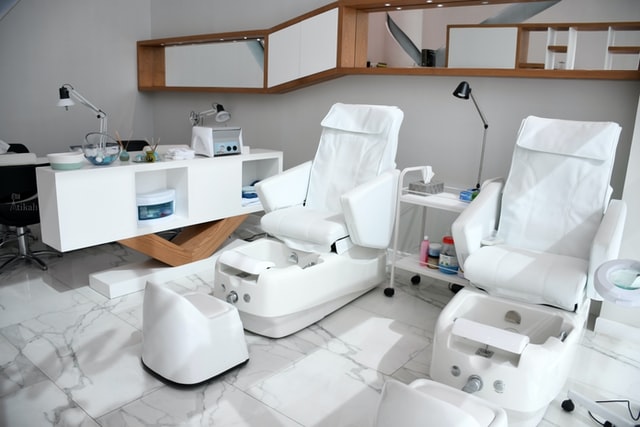
How to Start a Nail Salon Business
Thinking of starting a nail salon business? Then it’s definitely a great time.
In the U.S. alone, the nail salon industry is a massive one, with more than $8.3 billion in annual spending. So, whether you are an experienced nail technician thinking of starting your own business, or an entrepreneur looking for an opportunity in the beauty and wellness sector, then starting a nail salon business can be a lucrative opportunity for you.
A nail salon business has a fairly straightforward business model, so the entry barrier is relatively low. Not to mention, in a nail salon, you can offer a wide variety of services: manicuring, pedicuring, nail art, nail extensions, and more, so you can potentially get a diverse source of revenue from a recurring client base.
Yet, even if a nail salon is a lucrative business opportunity, it doesn’t mean you’ll automatically achieve success just by starting one. You’ll still need proper planning and the right strategy to help you achieve success.

In this guide, we will learn together how to start a successful nail salon business in 2022. Throughout this guide, you’ll learn about:
- Different types and niches of nail salon businesses
- How to make a solid nail salon business plan
- Choosing the perfect location for your nail salon business
- How to establish a budget and financial plan
- Legal requirements for starting a nail salon business
And more.
Without further ado, let us begin this guide.
Nail Salon Business: What Makes a Good Nail Salon?
We can’t start and run a successful nail salon if we don’t really know the criteria of a good nail salon.
It’s very important to try to understand your clients’ perspectives: their preferences of what makes a good nail salon, what kinds of nail technicians would they prefer? What types of decorations would work? What factors will convince them about a nail salon’s quality, trustworthiness, and credibility?
While the answers to those questions can vary depending on your location, target clientele, and other factors, here are some key criteria you should focus on in starting a great nail salon business:
- Hygiene
As a beauty and wellness business, it’s crucial for a nail salon business to always maintain an excellent standard for cleanliness and hygiene.

Maintain cleanliness in all aspects of the business: both your nail salon space and your staff should always look, smell, and feel clean. This may require you to conduct regular cleanliness training for employees and establish clear policies.
Keep in mind, however, that the smaller your salon space is, the more difficult it will be for you to maintain cleanliness since your salon will naturally look cluttered. You may need to be smart and put in more effort if you have a fairly small space.
- Service excellence
Ultimately, a nail salon business is a service business, and you should focus on consistently delivering high-quality service to your clients.
Focus on trying to understand your client’s needs and preferences regarding your services and attempt to always meet their expectations.
- Communications
Since your nail services will involve direct interactions with clients, the ability to maintain engaging two-way communication can be the most important factor determining the nail salon’s success.

If your staff can’t communicate well with your clients, or if your employees can’t communicate with each other, it’s a recipe for disaster.
It’s best to brief and train your employees regularly so they are well-informed and equipped with adequate communication skills.
- High-quality equipment
People do judge the book by its covers, and your clients may weigh your salon’s credibility and trustworthiness from the brand of equipment/tools/supplies your salon is using, as well as their condition.
It’s best to choose equipment and supplies from established and well-known brands and, if possible, partner up with credible and certified vendors.

- Health and safety
For a wellness business in a relatively small space like nail salons, maintaining great health and safety standards has always been important.
Yet, it’s arguably even more important today in the post-COVID situation, when naturally, more clients will have concerns regarding whether you’ve implemented adequate health and safety policies.
Starting Your Nail Salon Business: Step-By-Step Guide
There’s more to opening a nail salon, or any business at all, than simply renting/purchasing a space and registering the business with the state.
To ensure success, you’ll need adequate planning and careful research before you even choose a space for your nail salon business.
With that being said, you can start a nail salon business by following these steps:
Step 1: Planning Your Nail Salon Business
You should plan the nail salon business based on adequate research, or else your ‘plan’ would only be based on assumptions.

You should start by developing a business plan for your nail salon, but before that, you should conduct your research about:
- How much money do you need to start and run the nail salon business? (both in terms of startup capital and ongoing expenses)
- Who is your target clientele?
- What services/products will you offer, and how much will you charge your clients?
Here are a few pointers:
Startup Capital and Ongoing Expenses
Assuming you are going to start a brick-and-mortar nail salon business (another alternative is to start a mobile nail salon where you’ll be the one visiting your clients), then you’ll need to either rent or purchase a space.
The average size of a nail salon is 1,000 to 1,500 square feet. Property rental/purchase costs will vary depending on your location, but building/decorating the salon will typically cost around $100 per square foot.
So, you’ll need around $100,000 for the build-out cost of a 1,000 sq ft nail salon. Obviously, you’ll also need startup capital for purchasing equipment and supplies, although it’s typically lower than starting a fully-fledged beauty salon or a hair salon.

As for ongoing expenses, you’ll need to consider supply cost, overhead (employee salary and/or commission), taxes, maintenance, and insurance. To stay profitable, ongoing supply costs should not exceed 8 percent of your total revenue.
Pricing Strategy
Below are the industry average prices for common services provided in a nail salon business:
- Manicures ($10-$25)
- Pedicures ($25-50)
- Silk nails ($10-16)
- Full gel nails treatment($45-75)
- Full acrylic nails treatment($30-60)
It’s best to do a bit of competitive analysis to figure out how much your competitors are pricing their nail services in your area, but remember that you don’t always need to price your services cheaper, even if you are a new brand.
If you can offer something more valuable than your competition (and you can elaborate on it), then it’s perfectly okay to charge more.
Nail Salon Business Plan
A business plan is especially important if you are trying to secure outside funding for the business (i.e., loans or investors.)
However, even if you are planning to fund the business by yourself, we’d still recommend writing a business plan so you can have a clear roadmap for your salon’s success.
A typical nail salon business plan can follow this structure:
- Executive Summary
The first section of any business plan, and is arguably the most important. This will often be the first section to be read by readers and can be the only section they’ll read if it’s not engaging.
So, optimizing the executive summary section to make sure it’s attractive and engaging is crucial, especially if you are trying to secure funding with the business plan.

The executive summary should include:
- Your vision and mission
- The purpose of starting the nail salon business
- The services and products you’ll offer in the nail salon, and their prices
- Marketing/promotion plan
- Growth plans
Since the executive summary will be a summary of the following sections in the business plan, it’s typically best to write this section last once you’ve finished polishing the next sections of the business plan.
The executive summary shouldn’t exceed 10% of the whole business plan’s length. This means that if it’s a 10-page business plan, your executive summary should not be more than one page. Unless it’s a very long business plan, it’s typically best to keep the executive summary short and to the point within one page.
- Business Overview
This section should contain the basic information about your nail salon business, including:
- Purpose
- Vision and mission
- Short term and long term goals
- Services and products offered (with price)
- Target audience
- Unique Value Proposition (UVP)
It’s especially important to elaborate on your nail salon’s unique value proposition in this section: what can you offer that your competitors cannot? What makes your salon unique?
The better you can identify and elaborate on your UVP, the better you can design your nail salon to meet your target clientele’s expectations.
- Market Research
This section is about :
- Identifying who your target market is
- Discuss the details of your salon’s primary and secondary target market (i.e., demographics, behavior, online habits, etc.)
- Analyzing how you can attract this target clientele to visit your business
Again, based on these insights, identify your salon’s UVP and elaborate on how you can create a competitive advantage in your area.
- Marketing Plan
This section will cover how you plan to promote your nail salon and attract your target clientele. In this section, you should also list the services you are going to offer (nail treatment services or otherwise), products you’ll sell in your salon, and your pricing strategy.

- Competitive Analysis and Industry Analysis
Identify and analyze the direct and indirect competition for your salon, and elaborate on the detailed results of your competitive analysis in this section.
- Management Team and Organizational Strategy
Elaborate on your nail salon’s organization and management strategy, and list the members of your management. You may also want to include the nail salon business’s legal structure.
List your leaders, their qualifications, and describe their responsibilities.
- Operational Plan
This section should discuss in detail how you plan to run your nail salon business, like:
- Your opening hours
- Your location(s)
- How you plan to expand the business over time
- The kind of employees the business will need
- Design and Development Plans
Your nail salon business’s concept. Elaborate on why you choose this specific design and how you are going to turn this concept into reality.

- Financial Plan and Projection
Discuss how much money you’ll need to start and run the nail salon business, and how you are going to spend this money. It should also include detailed explanations of the key financial assumptions you’re using.
Also, discuss your revenue projection: how you plan to get paid from clients and generate income. Elaborate on your profitability model.
- Appendix
You should include a full set of financial projections in the appendix. For a salon business as a brick and mortar business, you can also include technical drawings, as well as other documents like customer lists and extensive competitor analysis.
Step 2: Figure Out The Legal Requirements for Starting The Business
Depending on your location, specific permits and licenses may be needed before you can start providing nail treatment services to your clients.
If you are located in the U.S., then you can start by visiting the Small Business Administration’s page for federal/state licenses and permits here.

In addition to state and federal regulations, there may be local licensing or other regulatory requirements that may be applicable to your nail business. Check with your town or county clerk’s office or any local associations in your area to get more information about this.
Also, if you are renting a space for your salon, your building’s owner may have specific regulations and policies you’ll need to follow. Make sure to ask the building’s owner about this before committing to a building.
Business Insurance
Again, different locations may have different regulations when it comes to insurance. However, even if you are not legally required to get insured, it’s always a good idea to get relevant insurance policies to protect your business and your financial wellbeing in the event of unwanted accidents or other losses.
At the very least, you should get General Liability insurance and Workers’ Compensation insurance if your business will have any employees working for you.

Certificate of Occupancy
If your nail salon is operating as a brick-and-mortar business, then you may be required to obtain a certificate of occupancy (CO). If you are leasing space, it’s typically the building owner’s responsibility to obtain a CO, so confirm with your landowner whether they have obtained a valid CO that is applicable for your nail salon.
If you are going to operate out of your own location, however, you must obtain the CO from a local authority. To do so, you must first meet all the building codes, zoning laws, and other applicable regulations.
Step 3: Finding an Ideal Location
The next step is to choose the perfect location for your nail salon based on your target market and the services you’ll offer.
When evaluating different location options, here are some key factors you’d want to consider:
- Local peak hours of the location
- Demographic data of people in and around the locality
- Traffic conditions around the location
- Parking availability
- Public transport availability
Obviously, the better the location is, typically the more expensive it will be. So, it’s best to identify a budget that works for you to maximize your return on investment.
Step 4: Branding
With the tight competition, it’s very important to build a strong branding for your salon, and there are three key branding elements you should focus on:
- Salon name: pick a name that’s easy to pronounce, easy to remember, and represents what your salon is.
- Logo: your logo should support your salon’s name and overall aesthetic. It’s important to find the right balance between your vision and the target market in your area.
- Interior and decoration: your salon’s interior should be a crucial aspect of your salon’s branding. Aim to create a good experience with your interior design to keep your clients coming back.

Step 5: Establish Pricing Strategy
How much should you price your services?
Unfortunately, the answer to this question can be rather subjective, and you’ll need to consider several different factors:
- Your location: the more premium your location is, the higher you can price your services. You may also need to factor in rental costs and mortgages when deciding your prices.
- Demand: services with higher demands can be priced higher, and vice versa.
- Competitors: perform a thorough competitive analysis and identify how your competitors approach their pricing strategies. If possible, figure out the average prices charged for each service in your area. You can then build your pricing strategy based on these insights.
Remember, however, that you don’t always need to make your prices more affordable than your competitors. If you can offer more value and quality than your competitors, then it’s perfectly okay to charge higher.
Step 6: Build a Strong Online Presence
Even though your nail salon is a brick-and-mortar business, in this digital age, it’s still very important to build a strong digital presence so you can get noticed by your target clientele.

No matter how good your salon’s concept and services are, you won’t get any business if your prospective clientele doesn’t know you exist, so focus on building a strong online presence in these four areas:
- Well-designed and functional website
Your website is your nail salon’s digital storefront. Prospective clients will most likely check out your website before they visit your store: if it’s well-designed and professional-looking, your salon will be perceived as credible, and vice versa.
And, even if you already have a pretty strong social media presence, your social media profiles are not an adequate replacement for your website.
With platforms like Wix and Squarespace, among others, it’s now very easy and affordable to build your own professional website, so there’s simply no reason not to have one.
- Online 24/7 Appointment Taking
Especially in today’s post-pandemic world, people expect the convenience of 24/7 online appointment booking. Also, consider the fact that many people now would like to book services (including booking nail salon services) outside business hours.

Choose a salon appointment scheduling software solution that supports Reserve With Google, so you can easily allow prospective clients to book your service from your Google Maps listing, as well as your website.
- Social Media Presence
Pretty self-explanatory, in today’s social media age, it’s very important to build a strong social media presence for your salon.
You should:
- Build followers on relevant social media networks based on your target audience
- Run contests and giveaways to build traction.
- Invest in paid social media advertising (i.e., Instagram ads) according to your available budget
- Reach out to relevant influencers in your location so they can help promote your salon
- Google Maps SEO
Nowadays, prospective clients will Google “nail salon near me”, “nail salon in (city name),” or other queries when they are looking to book a nail salon service.
So, if your nail salon doesn’t appear on the results for these queries, you are going to miss out on this sizable market.

Google now prioritizes results from Google Maps for this type of local search queries, so you’ll need to optimize your nail salon listing on Google Maps via four simple steps:
- Claiming and verifying your Google My Business listing
- Optimizing your listing, focus on providing complete and accurate information for your prospective clients
- Encourage (positive) reviews from your clients, mainly on Google Maps but also on relevant review sites
- Build local citations by listing your salon business on relevant online directories
Wrapping Up
Opening a nail salon can be a lucrative business opportunity with high earning potential while at the same time requiring fairly low startup costs.
Yet, although it’s a promising business, it doesn’t mean you’ll automatically achieve success, and you’ll still need proper planning and strategic steps to make sure you can win your target clientele and maintain your position in the market.
By following the actionable tips we’ve shared above, you are ready to plan and set up your successful nail salon business and achieve success.

